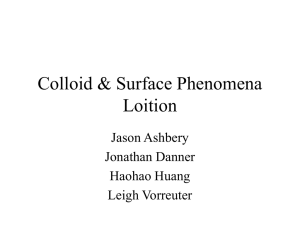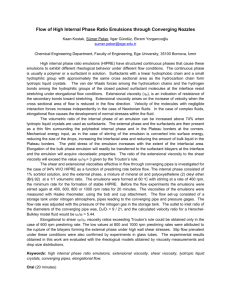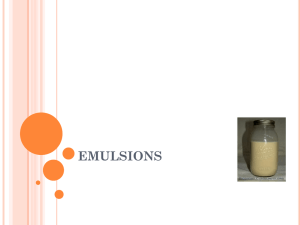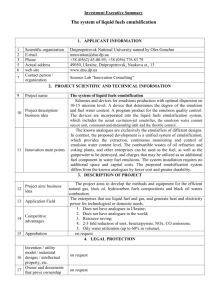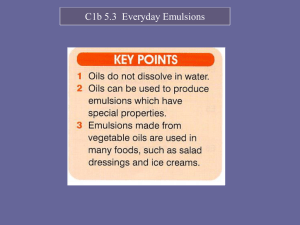Activity 2-1 Comparing Emulsions, Solutions & Suspensions
advertisement
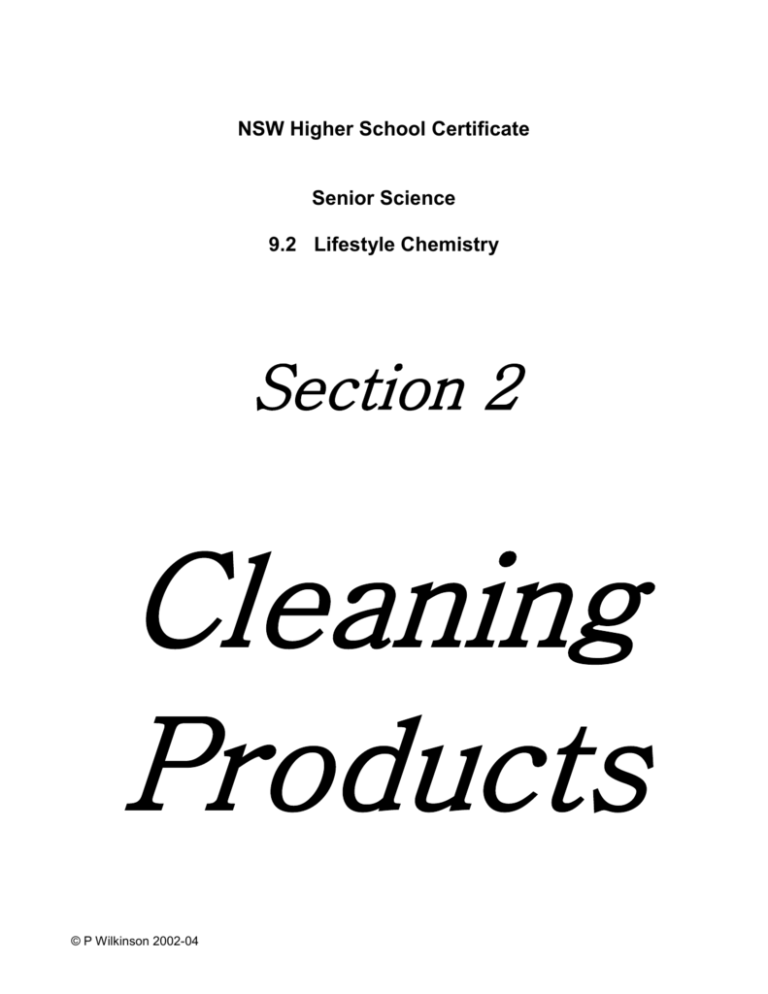
NSW Higher School Certificate Senior Science 9.2 Lifestyle Chemistry Section 2 Cleaning Products © P Wilkinson 2002-04 9.2 Lifestyle Chemistry – Section 2 ::: Cleaning Products 9.2.2 A wide range of cleaning products are made from colloids and surfactants 9.2.2.a State the relationship between the properties of an emulsion and the types of molecules present 9.2.2.b Outline the purpose of the emulsifying agent in a range of consumer cleaning products 9.2.2.c Identify that soaps and detergents are emulsifying agents and surfactants 9.2.2.d Explain why cleaning agents must be surfactants and emulsifiers 9.2.2.e Define the term biodegradable 9.2.2.f Discuss the biodegradability of soaps and soap less detergents 9.2.2.i Perform a first-hand investigation to prepare an emulsion and compare its properties to those of a solution and suspension 9.2.2.ii Plan, choose equipment or resources for, and perform a first-hand investigation to gather information about the properties of different emulsions and use available evidence to compare those properties © P Wilkinson 2002-04 2 9.2.2.i Perform a first-hand investigation to prepare an emulsion and compare its properties to those of a solution and suspension ACTIVITY 2-1 Comparing emulsions, solutions & suspensions Risk assessment Consider the risks associated with this investigation. Method Prepare six mixtures by following the instructions below Use a blender, or stir vigorously, to mix the following pairs of chemicals. In each case use a large quantity of water (100mL - 200mL) and a relatively small quantity of the other chemical (1mL – 5mL or a small quantity of crystals) MIXTURE 1 MIXTURE 2 MIXTURE 3 MIXTURE 4 MIXTURE 5 MIXTURE 6 copper sulphate and water olive oil, water and some detergent olive oil and water ethyl alcohol and water kerosene and water and some liquid soap starch and water Once the chemicals have been mixed pour or decant them into a large beaker. For each mixture complete the following instructions. 1. Observation by eye Look at all the mixtures a few minutes after blending. Describe what each mixture looks like a few minutes after blending. Can droplets or particles be seen in the mixtures? 2. Filtration Set up equipment for filtration. Pour about 10mL of the liquid onto the filter paper and also a semi permeable membrane (dialysis tubing). Leave for several minutes to see if the filter paper and/or the membrane trap any substance. Identify what happens for each mixture. 3. The Tyndall effect Produce a very weak mixture by adding a large quantity of water. Darken the room and then shine a torch or light beam through each mixture. Describe and/or draw what you see. 4. Leave the mixtures to stand overnight. Draw a labelled diagram of what happens. © P Wilkinson 2002-04 3 Results 1. Identify which mixtures are suspensions, solutions or emulsions. 2. Record results for all six mixtures (for each of the four tests) in a table. NB Comparison - Draw the table that compares the properties of suspensions, solutions & emulsions. - Draw a labelled diagram of each mixture – suspension, solution and emulsion. Phrases that could be used in the table include: - Droplets can be seen with the naked eye - A solid was trapped by the filter paper - All of the mixture passed through the dialysis tubing - The light beam is visible in the mixture Conclusion Write an appropriate conclusion Discussion [15 marks] 1. Write an aim for this investigation [1] 2. Outline two changes that could be made to the method. [2] 3. Describe how wastes were disposed of in this investigation. [2] 4. Identify two safe working practices that should be used in this investigation. 5. Identify the independent variable in this investigation? [1] 6. Identify the dependent variable in this investigation? [1] 7. Identify two controlled variables in this investigation? [2] 8. State one reason why this investigation produced valid results [1] 9. State one reason why this investigation produced reliable results. 10. Explain why an emulsion is a colloid. [2] Marking criteria for Laboratory report [10 marks] Syllabus Outcome - H12: 12.2 b Gather information 1. Observe and describe results 2. Tabulate results [2] [6] Syllabus Outcome - H13: 13.1 a Present information 3. Use laboratory scaffold © P Wilkinson 2002-04 [2] 4 [1] [2] 9.2.2.a State the relationship between the properties of an emulsion and the types of molecules present 9.2.2.ii …. gather information about the properties of different emulsions and use available evidence to compare those properties Properties Of Emulsions An emulsion is one type of colloid – a colloid containing a mixture of two liquids. In this case droplets of one liquid (the dispersed phase) are spread evenly throughout another, immiscible liquid (the dispersion medium). The two liquids do not dissolve in each other, as in a solution. The tiny droplets of the dispersed liquid remain suspended in the other liquid. As with all colloids the tiny droplets cannot be seen with the naked eye. Emulsions appear cloudy (milky white) because the droplets are big enough to scatter light. Emulsions are used in a wide variety of consumer products. These include cosmetic lotions, foods, lubricants, medicines and paints. Milk is a naturally occurring emulsion consisting of butterfat in water. Emulsions are widely used in cleaning products. In some skin products the emulsion is used to overcome the difficulties of applying substances to the skin, which are insoluble in water. For example, oils are needed to condition the outer layer of the skin, and products such as skin creams can be emulsions. Two common types of emulsions are: Oil-in-water emulsions In this emulsion the tiny oil droplets are spread throughout a continuous water phase. Water-in-oil emulsions In this emulsion tiny droplets of water are spread throughout a continuous oil phase. Each type of emulsion has distinct properties. Possible properties include: The emulsion can feel cool or feel greasy Water will mix easily with the emulsion [depending on the concentration of the water the emulsion can become a free flowing or creamy liquid. Water will not mix easily with the emulsion [these type of emulsions tend to be thicker pastes] The emulsion can be a poor or good conductor of electricity. Certain dyes will only dissolve in, and therefore stain, the dispersed phase of the emulsion (water-soluble dyes – Methyl orange; Oil-soluble dyes – Sudan III) The properties of an emulsion depend on the type of particles present. Oil-in-water emulsions have different properties to water-in-oil emulsions. Notes Questions 1. What is an emulsion? © P Wilkinson 2002-04 5 2. Name two features of an emulsion. 3. Why is it correct to identify an emulsion as a suspension rather than a solution? Support your answer with at least one reason. 4. Name three products where emulsions are used 5. In a water-in-oil emulsion: a. Which liquid is the dispersion medium and b. Which is the dispersed phase 6. Draw a labelled diagram of milk showing why it is a oil-in-water emulsion 7. Take a guess Which type of emulsion conducts electricity – W/O or O/W? © P Wilkinson 2002-04 6 9.2.2.ii Plan, choose equipment or resources for, and perform a first-hand investigation to gather information about the properties of different emulsions and use available evidence to compare those properties Activity 2-2 Identifying properties of different types of emulsions Use the possible properties listed on the previous page. The task is to use this information to plan and perform a first hand investigation to To determine the properties of O-in-W and W-in-O emulsions and To identify examples of each type of emulsion. Planning involves designing the tests needed to identify the properties of particular emulsions. Tests for several properties will need to be performed. Planning Information What to do 1. Write a heading for the investigation. The questions below might help in the discussion about which tests could be used 2. Write an aim for the investigation. [to be able to identify an oil-in-water emulsion from a water-in-oil emulsion]. 3. Write a method for the investigation. a. Discuss the tests that could be used. Should water be added to the emulsion? b. Select two or three tests. Can kerosene be used to test the emulsion? c. List the instructions to be followed for How is an electric circuit set up? each test, in point form. What would a suitable water-soluble dye? d. Draw labelled diagrams if necessary. What would a suitable oil soluble dye? How does the emulsion feel? 4. Make a list of equipment needed. For the instructions the following might be 5. List possible risks considered: How much of each emulsion should be used? 6. Record data in such a way to distinguish How much of the testing substance should be which emulsions were O/W and which used? – Drops or mL or …. were W/O. It is suggested that student’s trial various 7. Write a conclusion tests before the method is written. As various tests are trailed identify improvements made 8. Complete discussion to the method. © P Wilkinson 2002-04 7 Discussion [15 marks] Syllabus Outcome - H12: 2.1 a, b, c, d After trailing a number of tests it is important to consider possible improvements. The reliability and validity of the investigation can be considered. 1. Describe the wastes produced in this investigation. [2] 2. Outline how wastage of resources can be minimized in this investigation. [2] 3. Outline how the wastes produced can be safely or correctly disposed of. [2] 4. Identify safe working practices used in this investigation (used to reduce risks) [2] 5. Outline any problems found when trailing or performing your planned method. That is Were the results of all the tests obvious and/or Did the tests distinguish between the two types of emulsions? [3] 6. Identify changes or improvements that could be made to the method. [2] 7. Discuss the validity of the tests used to compare the properties of different emulsions (oilin-water and water-in-oil) [5] Validity means right method In this investigation it means that the tests used clearly distinguished between O/W and W/O emulsions. An investigation needs to be reliable to be valid. Marking criteria [10 marks] Syllabus Outcome - H11: 11.2 b, c, e 1. 2. 3. Justifying an appropriate investigation plan. Identify variables that need to be kept constant. Design investigations that allow valid and reliable data to be collected. Predict possible issues that may arise during the course of the investigation. Syllabus Outcome - H12: 12.2 b 4. Observe and describe results 5. Record results (table) [2] 6. Carry out repeat trials. [2] Syllabus Outcome - H13: 13.1 a Present information 7. Use laboratory scaffold [1] © P Wilkinson 2002-04 8 [5] © P Wilkinson 2002-04 9 9.2.2.b Outline the purpose of the emulsifying agent in a range of consumer cleaning products The purpose of emulsifying agents Rapidly stirring a small amount of olive oil in a large amount of water can form a suspension. The oil will break up into small droplets that will spread throughout the water. The resulting mixture appears white – very different from the original colour of the olive oil and the water. The suspended oil will slowly separate from the water. After a relatively short time a layer of oil will gradually develop on top of the water. Suspensions are obviously not permanently stable. Even emulsions are not permanently stable. That is, the two liquids separate from each other after a certain time. In many products it is desirable for the emulsion to remain stable. Increasing the stability of emulsions is achieved by using an emulsifying agent. An emulsifying agent is a surfactant. That is, it is a “surface active agent”. Surfactants work at the boundary (the interface) between two substances. A surfactant molecule has two chemical groups: one end that is attracted to water (hydrophilic) and the one that is attracted to substances that are not water soluble (hydrophobic). As an emulsifying agent the hydrophilic end of the molecule projects into the water. The hydrophobic end of the molecule projects into oil. When the mixture is shaken oil droplets form, and the surfactant molecules surround each of the dispersed droplets The molecules prevent the droplets from joining and so maintain the stability of the emulsion. The suspension has now been “emulsified” – an even spread of oil droplets in water that is relatively stable. Good description of surfactants and cleaning products can be found at the web site http://www.riponcomputer.com/riponcomputer/dawnchemical/chemistryofcleaning.htm Read the article on the Chemistry of cleaning In the cleaning process a number of steps occur. The soil needs to be lifted off the surface to be cleaned The soil needs to be surrounded by water molecules The soil needs to be broken up into small droplets and then kept separated The purpose of the surfactants in cleaning products is to break up greasy oil based compounds into small droplets. Then the emulsifying agent helps to thoroughly disperse the droplets and then keep the droplets separated. © P Wilkinson 2002-04 10 Notes Questions 8. Why is a mixture of olive oil and water a suspension? 9. How can suspensions be made more stable? 10. Describe a surfactant molecule. 11. Which end of the surfactant molecule attaches to the “oil” droplets? 12. “The surfactant molecules surround the dispersed droplets” Draw a diagram showing what is meant by this statement. 13. How do the surfactant molecules maintain the stability of the emulsion? 14. What is the purpose of emulsifying agents in cleaning products? © P Wilkinson 2002-04 11 9.2.2.c Identify that soaps and detergents are emulsifying agents and surfactants 9.2.2.d Explain why cleaning agents must be surfactants and emulsifiers What are soaps and detergents? A detergent is a substance that cleans soiled surfaces. Soap is a type of detergent. Soap is made from naturally occurring substances. The main ingredients are (1) animal fats or vegetable oils and (2) chemicals called alkalis. The process of making soaps is relatively simple and soap has been produced for over 3000 years. The word detergent normally refers to synthetic detergents. Synthetic detergents are made from chemicals found in petroleum. They were first developed in the early 20th century. A useful web site for more information on soaps and detergents is: http://www.fabrics.net/deterg.htm Soaps and detergents work at the boundaries of two substances. For this reason they are surface-active agents or surfactants. Surfactants are “surface active agents”. They work at the boundary between substances – the water and the soil. How cleaning agents work! Water alone will not clean most “soiled” surfaces. This is because most soils repel water. In order to work effectively a modern cleaning agent performs a number of functions. Soaps and detergents can carry out these functions because they are surfactants. The functions to be carried out are: 1. Cleaning Agents act as a wetting agent: Surface tension holds the molecules of water together. Surfactants reduce the surface tension of water. This causes the water molecules to spread out and penetrate the soiled material more completely. That is, surfactants act as a wetting agent. 2. Cleaning Agents remove particles of soil from the surface: In water based detergents one end of the surfactant molecule (the hydrophobic end) attaches itself to the “soil”. The other end of the surfactant molecule (the hydrophilic end) extends into the water solvent. Water molecules attract the hydrophilic end of the surfactant molecule. This causes the “soil” to be lifted away from the surface of the substance to be cleaned. 3. Cleaning Agents hold the soil particles in the water: Once the “soil” has been lifted from the surface, it needs to remain suspended in the water solvent until the water is rinsed away. The detergent molecule surrounds the “soil” and acts as an emulsifying agent. The individual molecules are kept separated. © P Wilkinson 2002-04 12 Notes Questions 15. What is soap? 16. What is the source of chemicals used for making detergents? 17. What property of surfactants allows them to act as wetting agents? 18. Research activity Put a drop of pure water onto some clothing materials. Does the water sink into the material? Put a drop of water with added detergent onto some clothing materials. Does the water sink into the material? Is there a difference in the wetting ability of water versus the water/detergent emulsion 19. How do surfactants lift “soil” off a surface? 20. When does the detergent molecule act as an emulsifying agent? © P Wilkinson 2002-04 13 9.2.2.e Define the term biodegradable 9.2.2.f Discuss the biodegradability of soaps and soap less detergents Biodegradable - Soaps and Soap less Detergents The biodegradability of a chemical is its capacity to be broken down by the biological action of living organisms. The end result is the complex chemical is converted into simple molecules of carbon dioxide, water and salts. Soaps are biodegradable; that is, they are quickly broken down by bacteria, and thus do not pollute rivers. While soaps have the advantage of not polluting waterways they do have a number of problems when compared to detergents. When used in hard water a sticky precipitate forms, which settles on the material being cleaned. Another residue remains on the material because soap does not completely rinse out. Finally, soaps do not have the cleaning power of modern synthetic surfactants. Modern cleaning agents can be formulated specially for particular cleaning jobs. Early detergents were not completely biodegradable. They sometimes produced large amounts of foam in rivers and streams that received sewerage effluent. Many modern detergents use compounds containing phosphate. This chemical is a fertilizer for plants and causes problems such as blue-green algae outbreaks and eutrophication. So, even though modern detergents are biodegradable, they can still cause problems to the environment. Scientists are continuing to develop detergents where the biodegradable products do not cause environmental problems. Today, while phosphates are still used in detergents, it is possible to buy and use phosphate-free detergents. Notes Questions 21. Why are soaps biodegradable? 22. Identify one problem associated with the use of soaps. 23. What is a soap-less detergent? 24. Outline the problem associated with the use of early detergents. 25. Why is the use of phosphates in detergents a problem? 26. Explain why modern detergents containing phosphates biodegradable? © P Wilkinson 2002-04 14 HSC style questions Low band questions 1. Outline the purpose of the emulsifying agent in a range of consumer cleaning products. 1 H, H 9.2.2.b HSC style question Marks Marking Criteria 2 Marks 2 1 2. Define the term biodegradable 2 H, H 9.2.2.e HSC style question Marks Marking Criteria 2 Marks 2 1 3. High band questions 4. Discuss the biodegradability of soaps and soap less detergents 9.2.2.f 4 H, H 9.2.2.f HSC style question Marks Marking Criteria 7 Marks 2 1 9.2.2 A wide range of cleaning products are made from colloids and surfactants 9.2.2.a State the relationship between the properties of an emulsion and the types of molecules present 9.2.2.c Identify that soaps and detergents are emulsifying agents and surfactants 9.2.2.d Explain why cleaning agents must be surfactants and emulsifiers 9.2.2.i Perform a first-hand investigation to prepare an emulsion and compare its properties to those of a solution and suspension © P Wilkinson 2002-04 15 9.2.2.ii Plan, choose equipment or resources for, and perform a first-hand investigation to gather information about the properties of different emulsions and use available evidence to compare those properties © P Wilkinson 2002-04 16



